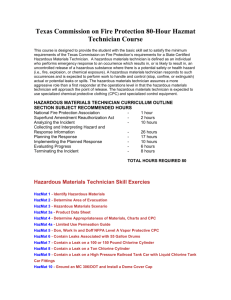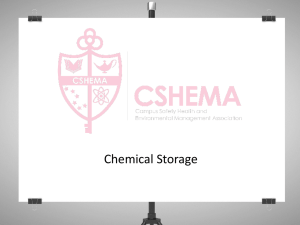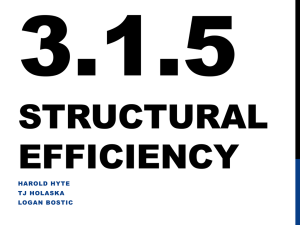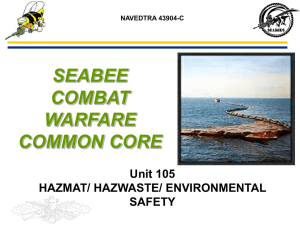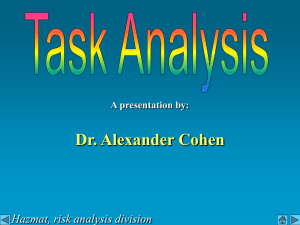Awareness Refresher - West Thurston Training
advertisement
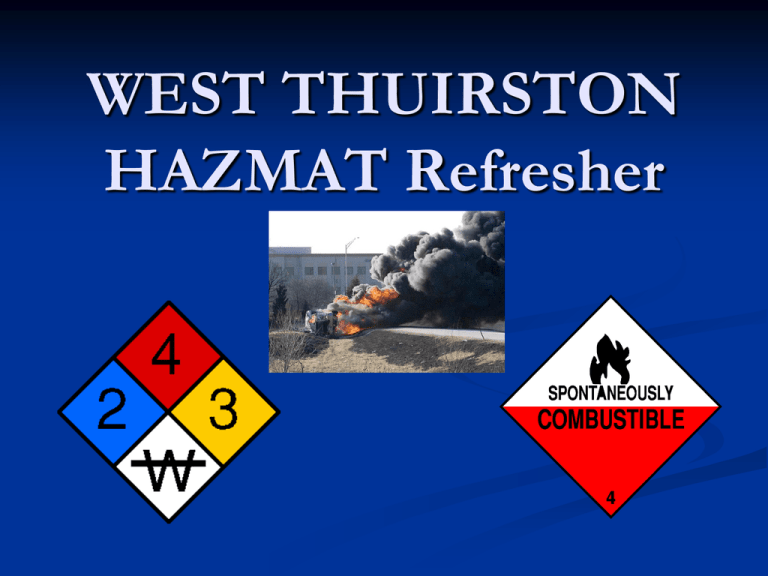
WEST THUIRSTON HAZMAT Refresher WA L&I HAZMAT Training Rules Emergency Response (WAC 296-824) Uncontained HAZMAT events First Response Hazardous Waste Operations (WAC 829-843) HAZMAT Cleanup Operations WA L&I HAZMAT Training Levels Awareness Operations Technician HAZMAT Specialist Incident Commander Specialist Employee Skilled Support Personnel Incident Safety Officer WA L&I HAZMAT Training Levels Emergency Response (WAC 296-824) AWARENESS Likely to witness or discover a hazmat release Training to make notifications to initiate a response Take no further action TRAINING RULE WAC 296-824-300 Awareness Level Understand what hazardous substances are and their associated risks. Recognize the presence of hazardous substances in an emergency. Can Identify the hazardous substances, when possible. TRAINING RULE WAC 296-824-300 Awareness Level Understand the role of a first responder at the awareness level as described in: The employer’s emergency response plan, including site security and control. The United States Department of Transportation’s Emergency Response Guidebook. TRAINING RULE WAC 296-824-300 Awareness Level Can use the USDOT’s Emergency Response Guidebook Recognize the need for additional resources and the need to notify the incident’s communication center accordingly. WA L&I HAZMAT Training Levels Emergency Response (WAC 296-824) OPERATIONS Respond to HAZMAT releases Defensive actions in order to: Confine the release Protect others TRAINING RULE WAC 296-824-300 Operations Level ALL OF THE COMPETENCIES FOR THE FIRST RESPONDER LEVEL, PLUS: Know basic hazard and risk assessment techniques. Can select and use personal protective equipment (PPE) appropriate for first responder operations level. Understand basic hazardous materials terms. TRAINING RULE WAC 296-824-300 Operations Level Can perform basic control, containment, and/or confinement operations within the capabilities of the resources and PPE available. Can implement decontamination procedures at their level of training. WA L&I HAZMAT Training Levels Emergency Response (WAC 296-824) TECHNICIAN Respond to HAZMAT releases Offensive actions in order to: Plug Patch Stop the release First Responder Levels Definition: Those persons who, in the course of normal duties, could be the first on the scene of an emergency involving hazmat. Awareness: recognize the presence of hazardous materials, protect themselves, call for trained personnel, and secure the area. Operations: Defensive measures, not offensive. Technician: Offensive, hands-on measures. Goal – Awareness Level 1) Analyze the incident to determine: The HAZMAT present Response Information for each hazmat 2) Implement protective actions and notifications: Local Emergency Response Plan North American Emergency Response Guide Employer SOPs HAZMAT DOT Hazmat Definition: A material that poses an unreasonable risk to the health and safety of people and the environment if not properly controlled during all uses. Hazard Classes/Divisions 1) 2) 3) 4) 5) 6) 7) 8) 9) Explosive Gases Flammable Liquids Flammable Solids Oxidizers Poison/Toxic/Infectious Substances Radioactive Corrosive Miscellaneous Explosives 1.1 1.2 1.3 1.4 1.5 1.6 Mass Explosion Hazard Projection Hazard Predominantly Fire Hazard No Significant Blast Hazard Very Insensitive Extremely Insensitive Gases 2.1 Non Flammable/Non Toxic 2.2 Flammable Gases 2.3 Toxic 2.4 Corrosive Gases Tacoma Propane Explosion - Video Is the scene safe? Flammable Liquids Flammable Liquids Flash Point < 140 °F Combustible Liquids Flash Point > 140 °F Flammable Solids 4.1 Flammable Solids 4.2 Spontaneously Combustible 4.3 Dangerous When Wet Oxidizers and Organic Peroxides 5.1 Oxidizers 5.2 Organic Peroxides Poison, Toxic and Infectious Substances 6.1 Toxic Materials 6.2 Infectious Substances What is this guy doing? Radioactive Materials Corrosive Materials Miscellaneous 9.1 Miscellaneous Dangerous Goods 9.2 Environmentally Hazardous Substances 9.2 Dangerous Waste Dangerous NFPA 704 Diamond Fire Health Special Hazard Acid, Alk, Cor, Reactivity Stationary Hazardous Materials Identification Guide Hazardous Waste Labels Placards Diamond-shaped (square on point) 10 and 3/4 inches on a side Located on all four sides of a vehicle May also have ID # on a Panel 1203 Labels Similar to Hazard Class placards May be more descriptive than placards More labels than placards Diamond-shaped 4 inches on a side Located on individual packages Placards and Labels SYMBOL NAME or ID # COLOR 2 HAZARD CLASS/ Division ID Numbers 1090 Shipping Papers Must accompany hazmat shipments Must include Proper shipping name (approx. 3,000) Use hazard class with NOS for all others Hazard class and division ID number Quantity of material Name of shipper Must be printed in English Shipping Papers (cont.) Highway Bill of Lading In cab of vehicle Driver is responsible Rail Waybill or consist With conductor or engineer who are responsible Describes where HAZMAT are located Shipping Papers (cont.) Water Dangerous Cargo Manifest Near wheelhouse of a ship or in a pipe-like container on a barge Captain or master is responsible Air Airbill In cockpit Pilot is responsible Material Safety Data Sheet OSHA Hazard Communication Standard: Required for employers who use or store Hazmat. Manufacturer and Identification Hazardous Ingredients Physical/Chemical Characteristics Fire and Explosion Hazard Reactivity Data Health Hazard Data Precautions for Safe Handling and Use Control Measures Notification 911 WSP/Ecology Division of Emergency Management 1-800-258-5990 EPA/U.S. Coast Guard National Response Center 1-800-424-8802 2004 NAERG ERG • Approximately 3,600 chemicals separated into 62 guide sections • Developed for use by First Responders • Designed as an initial action guide • Guide hazards and recommendations are conservative (based on worst characteristics in the group) Yellow Pages ID Number Blue Pages Chemical Name Orange Pages Guide Numbers Green Pages Initial Isolation Commodity Name Steps for Using the ERG 1) Identify the material (name or ID#) 2) Look up the materials Guide Number Guide Page may have ‘P’ – Polymerization Hazard Entry may be highlighted – Toxic Inhalation Hazard or Water Reactive w/TIH proceed to green pages and begin protective action immediately 3) Turn to the Guide and read carefully Poor or missing Information If no information exists - use Guide 111 If placard is visible - use pages 16/17 If container type is known - use pages 18/19 Table of Placards Rail/Highway Chart Hazardous Material? Pressurized Covered Hopper Low Pressure Tank Car Tank Car? Pressurized Tank Car Low Pressure Tank Car What the Heck? Non-Pressure Liquid Tank Corrosive Liquid Tank Intermodal Hazardous Materials? Initial Isolation Distances Small vs. Large Spills One drum (55 gallons or 200 L) Single small package or cylinder Day vs. Night Atmospheric stability Guide Terms • • • • • • • Polar = Miscible Non-Polar = Immiscible Noxious Unstable Contamination Sensitive Self-Reactive Halogenated Solvents Initial Isolation and Protective Action Zones NAERG Exercise What is the Guide Page for acrolein? What is the primary hazard to responders? Are structural firefighters clothing adequate protection from this hazard? Should you establish an initial isolation distance, and if so, how far? Are there any other hazards that responders should be aware of? NAERG Exercise During the night, a neighborhood has been impacted by “ammonia” odors coming from a large tank (100 gallon) in a home suspected of being a drug lab. What are the primary hazards to responders? Should an isolation area be established, and if so, for how far? What would your isolation zone be shaped like? NAERG Exercise You respond to a 10’x 40’ shed that is on fire. The owner is on scene and says that the shed contains power/lawn equipment and fuel and 20 five-gallon containers of a chemical called acetone cyanohydrin. What is the appropriate volume of water to apply to fight the fire. ERG • Additional considerations • • • • • • Wind direction and speed Local population Time of day Surface area of spill Weather conditions Topography Thurston County Hazmat Hot Spots Data Source EPCRA SARA Title III Tier II Reporting Not Complete List – only > TPCs Volume Hazard Mobility 70 Facilities with over 10,000,000 lbs Gasoline Shell (Olympic Pipeline), Linderson Wy. 50,000,000 lbs Gasoline 50,000,000 lbs Diesel 1,000,000 lbs Gasoline additiive 1,000,000 lbs Transmix Many Facilities with 1,000,000 lbs 71 Facilities with over 1,000,000 lbs Propane Ferrelgas, Maytown ACME Fuel, Olympia CENEX, Yelm C&D Propane, Centrailia C&D Propane, Black LK Blvd. LASCO Bathware, Yelm Lots and lots of others < 1,000,000 lbs 72 Facilities with over 100,000 lbs Oxygen St. Pete’s Hospital, Olympia Capital Medical Center, Olympia Domsea Broodstock, Rochester Mt. Rainier Clinic, Yelm 73 Facilities with over 10,000 lbs Sulfuric Acid Target, Marvin Rd. 1,000,000 lbs Crown Beverage, Fones Rd. 100,000 lbs Qwest, Olympia 100,000 lbs Lots of others <100,000 lbs 74 Other Materials Facility Location Material Mutual Materials Crown Beverage Tumwater HCl 100,000 Fones Rd. HF 100,000 CH2O 8800 Old Hyw. 99 10,000 10,000 10,000 10,000 Br2 Cl2 HF H3NO2 Amount lbs 75 Other Materials (cont.) Facility Location Material Columbia Beverage Tumwater, NH3 Johnson Cl2 Blvd. CO2 Amount lbs 10,000 10,000 100,000 76 X+Y=Z Conclusion Questions, concerns, comments, observations?
